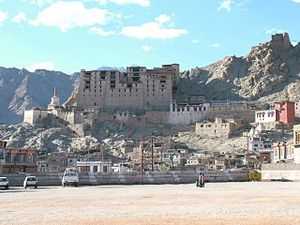Leh Palace


Leh Palace is a former royal palace overlooking the Ladakhi Himalayan town of Leh. Modelled on the Potala Palace in Lhasa, Tibet, the palace was built by King Sengge Namgyal in the 17th century. It is nine storeys high; the upper floors accommodated the royal family, while the lower floors held stables and store rooms.
The palace was abandoned when Dogra forces took control of Ladakh in the mid 19th century, and the royal family moved to Stok Palace.
The ruined palace is being restored by the Archaeological Survey of India. The palace is open to the public and the roof provides panoramic views of Leh and the surrounding areas. The mountain of Stok Kangri in the Zangskar mountain range is visible across the Indus valley to the south, with the Ladakh mountain range rising behind the palace to the north.[1][2]
The Palace Museum holds a rich collection of jewellery, ornaments, ceremonial dresses and crowns. Chinese thangka or sooth paintings which are more than 450 years old, with intricate designs, retain bright and pleasing colours derived from crushed and powdered gems and stones.[3]
History
The construction of the palace on the Tsemo Hill was initiated by Tsewang Namgyal, the founder of the Namgyal dynasty of Ladakh in 1553 and was completed by his nephew Sengge Namgyal.
References
- ↑ Leh Ladakh
- ↑ Staff. "Monuments of India : Leh Palace". iloveIndia.com. Retrieved 2010-02-04.
- ↑ Buddhist Art Frontline Magazine , pg 78, May 13-26, 1989
External links
| Wikimedia Commons has media related to Leh Palace. |
Coordinates: 34°9′58.6″N 77°35′11″E / 34.166278°N 77.58639°E